© AI generated image
There is a well-known old saying: “Power corrupts; absolute power corrupts absolutely”. Looking around the world at today’s political scene you can see how extraordinarily true that is. Just look at some of the more autocratic leaders that continually make the headlines and their power is obvious; even frighteningly so, in some cases. These are people who, having climbed the ladder to power seem keen to stop anyone from following. It has always been so: the truly powerful can be extremely ruthless in how they close the doors against potential rivals. Major world leaders have always been inclined that way: after all, you wouldn’t want to have invited Julius Caesar, Benito Mussolini, Joseph Stalin, Mao Tse Tung or Adolf Hitler round for a quiet drink. At least, not if you wanted to survive the experience. Actually, a chat with Julius Caesar might have proved interesting, although you’d have had to watch out for his sword, his gladius (the Roman short sword favoured by gladiators), if he started waving it about. I’d have to really polish up my Latin, too.
But that’s political power, which may well be what some countries get, even though their real and rather more urgent need is for electrical power. The world is hungry for it but there’s never enough. Can it be made to go around sufficiently? How about solar power? Power from the sun sounds like a wonderful, almost pollution-free solution to the problem. But nothing is ever that simple. I live in a fairly rural part of England, surrounded by fields and farms. Plenty of places in which to harvest the sun’s rays, you might think. But even here you can see a lot of placards and posters protesting against solar panels and claiming that they threaten the rural landscape and environment. Interestingly, many of those same farmers (or perhaps the landowners from whom they rent their fields) seem keen to sell off their land for urban development, and I note a growing rash of new building on the farmers’ fields, mostly small private houses with tiny gardens, unserved by adequate roads, public transport, shops or schools. Very environmentally and socially responsible, eh? In France, where solar dishes are erected, they mainly have tilting mechanisms that allow them to be moved temporarily out of the way so that the business of farming can continue without shading out crops or letting the cows and sheep get too chilly.
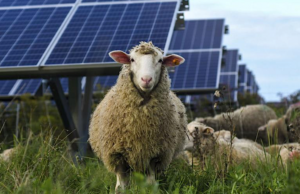
I’ve yet to see a similar arrangement in the UK. It’s as if the farmers (or the land-owners, as I mentioned) fear that solar dishes will frighten or even harm their sheep or cattle. I’m assuming that many such farmers will happily sunbathe, given the opportunity. Yes, I know that solar dishes can be unsightly, but certainly not more so than a rash of tiny new-build houses without any handy nearby amenities. Great to live in as long as you never need to buy anything and don’t mind a two kilometre walk to the nearest small supermarket or corner shop. In the rain, of course.
| TURN ME ON!
Perhaps we should start by looking at just what solar power is and how it works. We all know that sunlight in a huge source of energy, much required for the growth of plants, forests and healthy animals. In some cases, however, it’s not necessary, it seems. Recent research into subterranean life has revealed that living creatures can demonstrate great determination in surviving unappealing environments. In her new book, “Intraterrestrials”, writer Karen G. Lloyd writes that “we have not yet encountered a depth at which life ceases to exist.” Microbial life, after all, exists in the deep biosphere, where living things, however weird and unworldly, can find the sustenance they need in, for instance, the methanogens given off by rotting plants deep underneath swamps, while chemolithotrophs can still find a way to breathe on top of rocks three kilometres below the surface and thus very far from sunlight and its reassuring, life-giving warmth. Solar power can work in various ways. There is the photovoltaic method, in which sunlight hits the necessary cells, energising electrons, which creates an electric current. Not surprisingly, it’s direct current (DC) which then has to be converted into alternating current (AC) for everyday use. Of course, sunlight can simply be used to generate heat, which can, perhaps, produce steam which in turn can drive a turbine, producing electricity in a more conventional way. It may be necessary in this case to focus the available sunlight in some way, perhaps using mirrors or lenses to concentrate it.

“Concentrating Solar-Therman Power”, or CSP, can be scaled up for use in power plants. It can also be stored so that power remains available even when the sun isn’t shining. As you know, in some parts of Europe there are many days that aren’t particularly sunny.
As its supporters point out, solar power is sustainable and reduces the reliance on fossil fuels without producing harmful emissions that pollute the atmosphere and cause various illnesses. It’s cost-effective, too, since no-one has to climb up into the clouds each morning to switch the sun on or turn pedals to keep it shining. Even so, although sales of electrically powered cars are on the rise, they don’t seem popular with everyone. The fact is that with petrol cars, the business of introducing a new source of power when energy dwindles involves a simple visit to a petrol (gasoline) station and spending mere moments holding the spout of the pump in your vehicle’s fuel tank. Recharging an electric vehicle is an altogether different and more complicated operation. One person I know who decided to invest in an electric car found they had to have major work done on the garage in order to install the recharging equipment, which also takes longer to achieve. It’s not like putting new batteries in some electrical device.
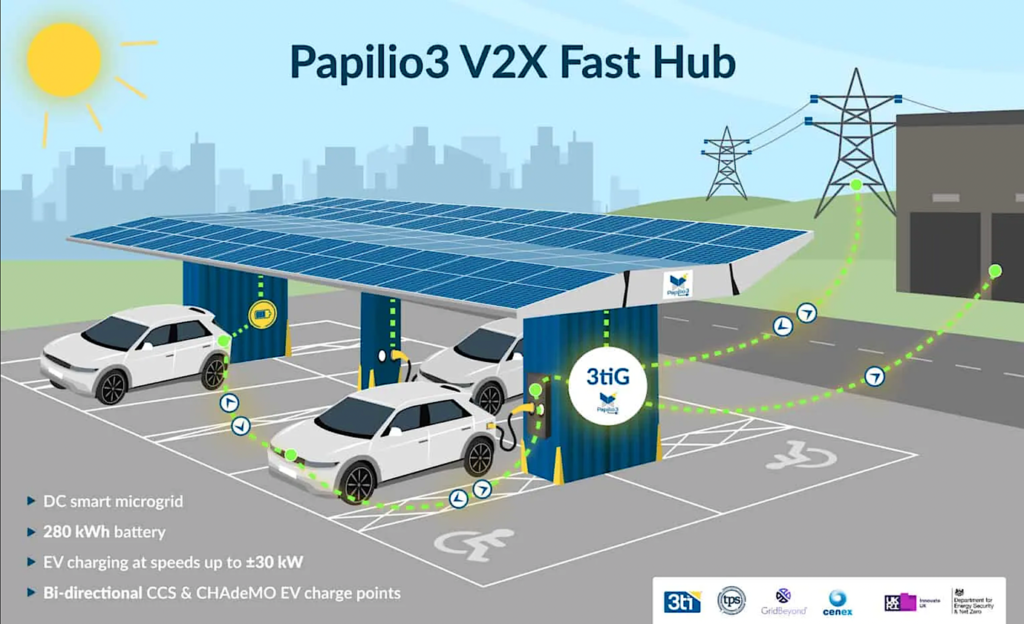
3ti, the UK’s leading designer, installer, funder, and operator of solar car parks (SCPs), is leading the new project funded by the Department for Energy Security and Net Zero, delivered by Innovate UK. The project is setting out to integrate bi-directional DC charging and the associated power management systems into Papilio3, a pop-up solar car park and EV charging hub
| HOW MUCH IS TOO MUCH?
Even so, as the British consumer magazine, “Which”, reported, they are finding a market. “Electric vehicles (EVs) are continually gaining popularity in the UK, making up a fifth of all new cars registered in 2024 according to the Society of Motor Manufacturers and Traders (SMMT). But that doesn’t mean they’re right for everybody, and there are lots of questions you need to be able to answer before you put money down on an EV,” says the article. Charging your vehicle at home may be cheaper than doing so at some pay-as-you-go recharging point, but it involves a sizeable investment in creating a home charging point. It’s clearly much more difficult for those people who are obliged to park their vehicle on a public road. Many of the new houses I’ve seen being chucked up lately totally lack a parking facility or anywhere to install recharging facilities, of course. Britain offers no financial support to anyone wanting to install a home charger and if you want one (and have room for one) it’s likely to cost around €1,400. That’s just a round figure estimate, of course. Proponents of electric power will argue that it works out cheaper than pouring petrol (gasoline) or diesel into it but recouping the cost of charger installation will still take time. You can console yourself with the thought that electrical power is cleaner, more efficient, produces fewer harmful emissions and it’s quieter, of course. It’s just a case of asking how an electric vehicle will fit with your lifestyle, your daily use of the roads and your work. Overall, running an electric vehicle (EV) is said to be cheaper than driving a traditional fossil-fuel-powered type. After all, solar power harnesses the sun’s energy efficiently, thus providing a clean and sustainable energy source. We should remember that fossil fuel was itself created out of plants or animals that had relied on the sun. It’s still solar energy, but somehow second-hand.
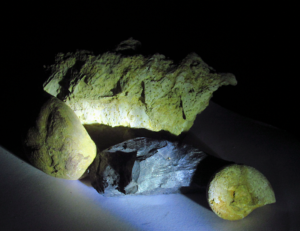
Perhaps we should remind ourselves that fossil fuels owe their existence to the sun. Millions of years ago, those microscopic animals and plants known as plankton and algae sank to the bottom of the sea and became buried in mud and silt. As the layers of sediment grew thicker, the pressure of them grew, too, slowly changing those fossilised remains into crude oil and natural gas. It must have taken a very, very long time, but so it was that creatures that owed their very existence to sun light came to provide an alternative source of energy. Isn’t nature wonderful? OK, sometimes rather slow but still wonderful. It’s still happening, too, of course, with microbial processes producing sugars from chemical reaction. These are then consumed by microbes, which are, in turn, eaten by such creatures as tube worms. They become a food source for vent crabs, the bythograeidae, which are a small family of blind crabs living around hydrothermal vents. These crabs, in their turn, become dinner for various kinds of fish.
How do they find the energy? Well, water laden with minerals, heated by magma deep within the Earth, flows out of the sea floor from chimney-like structures knows as “black smokers” (because they give off smoke which tends to be black) and in that smoke microbes convert the fluid into energy through what’s called “chemosynthesis”. If course, we mustb’t forget all these salt ions in sea water, producing sulphates, magnesium, sodium and chlotide. Just think: all that potential for generating energy.
| POSITIVES AND NEGATIVES
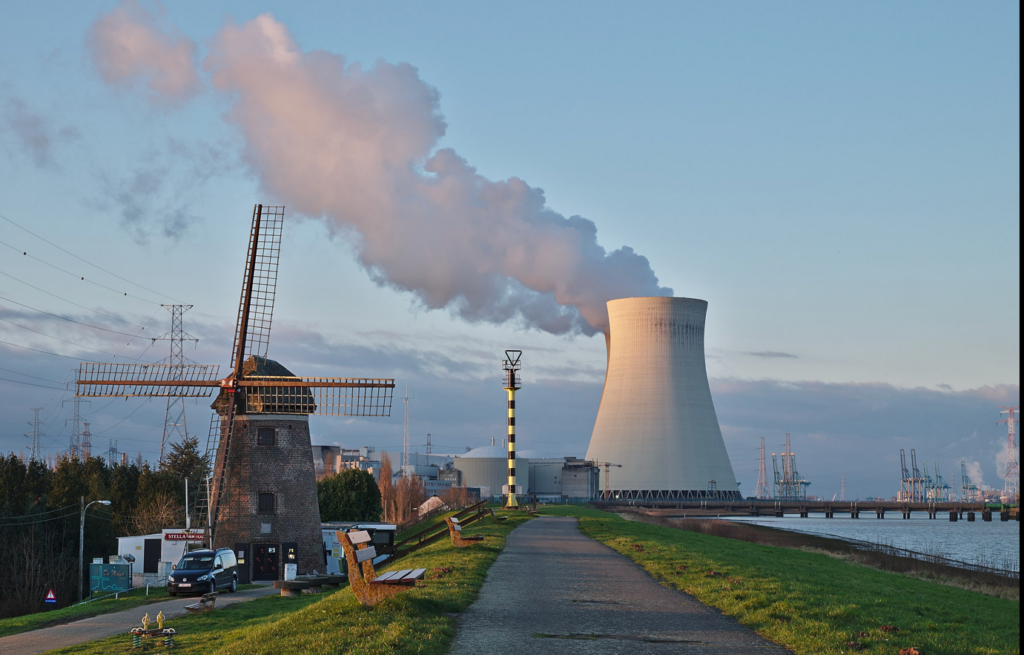
Of course, all this potentially free energy has a downside. Hasn’t everything? In this case there has been over-production of solar and wind power in some countries, like Spain, overloading the distribution network, so that some generators are now being paid to stop producing electricity. And, of course, there is inevitable power variability caused by changing weather and changing demand according to the time of day. Nuclear power stations have found themselves having to vary their output, reducing it when the sun is especially bright so as to avoid what’s called “thermal stress”. There could be long term effects, too. Grid stability remains an issue, while Europe’s manufacturing of solar power equipment rather lags behind what some other (mainly hotter) countries have been achieving. There is a clear need for much greater investment in storage and in grid infrastructure. That’s not the only problem, either. Solar panel connections with power stations are vulnerable to hacking. According to New Scientist magazine power grids around the world are growing increasingly concerned about cyberattacks, and for good reason.
| FAIR DINKUM (OR UNFAIR DINKUM?)
Rooftop solar panels are growing increasingly popular, especially in Australia (hence my use of the expression “fair dinkum”, which is an Australian phrase used to mean ‘honest’ or ‘real’). It seems that one in three Australian homes has rooftop solar panels, making users rather vulnerable to crooks. In reality, it also means that grids are becoming increasingly reliant on “smart inverters”, which manage the connections to local power networks, even though they’re not inviolably safe. “While these technologies offer many benefits,” Sid Chau of CSIRO, an Australian government research station, told New Scientist, “they also introduce new operational and cybersecurity challenges.” Who was it who first said: “there’s no such thing as a free lunch”? Smart inverters convert the direct current produced by solar panels into the alternating current required to operate the world’s various electrical appliances. Chau has warned that the vulnerabilities thus exposed could pose a considerable threat not just to home-based solar systems but also to the wider power generation network.
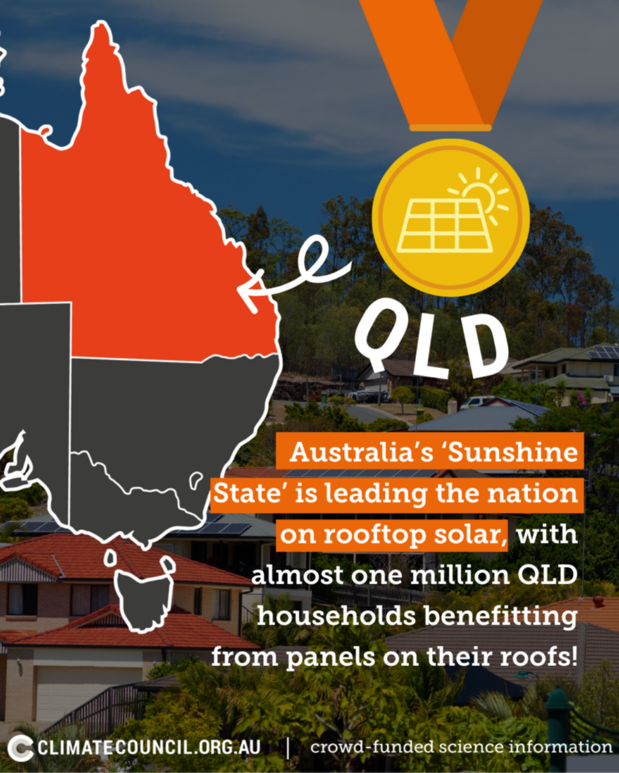
Chau and his team identified a large number of ways in which smart inverters could be hacked by crooks, including by exploiting the security flaws in the physical hardware and software of the smart inverters themselves. Such an attack would have to be very carefully planned but given the right circumstances you wouldn’t need to hack very many inverters to cause the sort of disruption you can use. Researchers say that if hackers were to mount a coordinated attack on a handful of solar inverters, which are then compromised, they can attack the broader power grid. The biggest fear is that the crooks could attack the power grid’s “frequency control”, which are potentially very vulnerable. Power grids in Australia – but also in Europe – require grid frequency to remain stable at around 50 hertz. Any deviation could, theoretically, cause cascading power-system outages. Another perceived weakness is, ironically, that inverters last a very long time – up to 15 years or even longer – which means that whatever cybersecurity defences they may have in place can be quickly out-dated. Chau has said that the authorities must develop better oversight of all private smart inverters so that in the event of some kind of attack, it can quickly be spotted and those giving rise to concern can be overridden. Also in Australia, Ernest Foo at Brisbane’s Griffith University says the infrastructure is especially vulnerable because of the age of the design and the components it uses. He has also warned that “with the help of a bigger uptake of distributed photovoltaics and perhaps with the use of machine learning and AI, cyberattack is more likely that previously thought.” Perhaps the only truly safe alternative to extracting electrical power from sunlight is to erect a yurt and gather firewood in a nearby forest. Nobody could hack that, although brigands could presumably turn up and hack you and your wider family with their edged weapons. Very unpleasant.
| DOTS BUT NO DASHES

Perhaps our wonderful and very varied universe can come up with some sort of alternative. Just take a look at what astronomers are now studying. They’ve been named “LRDs”, which stands, somewhat quaintly, for “Little Red Dots” (I love the prosaic names astronomers and physicists often use to identify the things they’re studying). Nobody quite knows what they are, although they’re thought to be (probably) compact objects from the very early universe, possibly linked to some process such as the creation of supermassive black holes, but in their early youth. They were at first believed to be very ancient, but now LRDs have been spotted that seem to be from a more up-to-date universe, having been identified as coming from a time some twelve billion years after the big bang, which makes them quite recent in astronomical terms. Could they possibly prove to be a possible future source of energy? Probably not, but with astrophysics one can never tell. In any case, these latest LRDs are quite nearby – just 2.5-billion billion light years from us. When I call them “Little Red Dots, that is somewhat stretching the definition of “little”, with each one something like a million times as massive as our sun and as wide as our entire solar system. When such unexpected things keep turning up out of the blue, who can say what sort of power they may promise us for the future.
The universe is scattered with matter of many kinds, albeit mostly the gases hydrogen and helium. With such tiny particles (or are they waves?), the force of gravity is quite weak, but it’s still there and there is no hurry. So what if it takes billions of years for gravity to assemble enough matter to be noticeable, even under a hugely powerful microscope, the universe has lots of time. Once those miniscule particles are assembled and begin to have mass, then gravity starts to develop heat, as it drags in more and more matter. It’s the energy of matter moving that leads to friction and so starts to provide heat. We must recall that these particles are not like bricks or stones; they’re quantum particles. Gathering them together will, of course, take billions of years.

As Brian Clegg explains, in his excellent and fascinating book, Dark Matter and Dark Energy, the more matter clumps together, the stronger its gravitational attraction and it forms into a ball of sorts, mainly comprising hydrogen – and we’re talking about hydrogen ions: atoms whose electrons have been stripped off by heat. Crushed together, the body they form will be getting bigger and also much hotter.
Remember, quantum particles can have wide variety of behaviours and values. Their exact location is often unknown. meanwhile, positively charged hydrogen ions repel each other because of electromagnetic force, and even under the extreme pressures and temperatures the ions cannot get close enough to each other to react. Tunnelling is one option, and in that way, a small percentage of the ions can get close enough to each other to get a reaction. It’s at that point that that the so-called strong nuclear force takes over, attracting them to get closer and closer. Eventually, after a long and extremely complicated procedure, the hydrogen ions can fuse, creating something completely new: a helium ion.
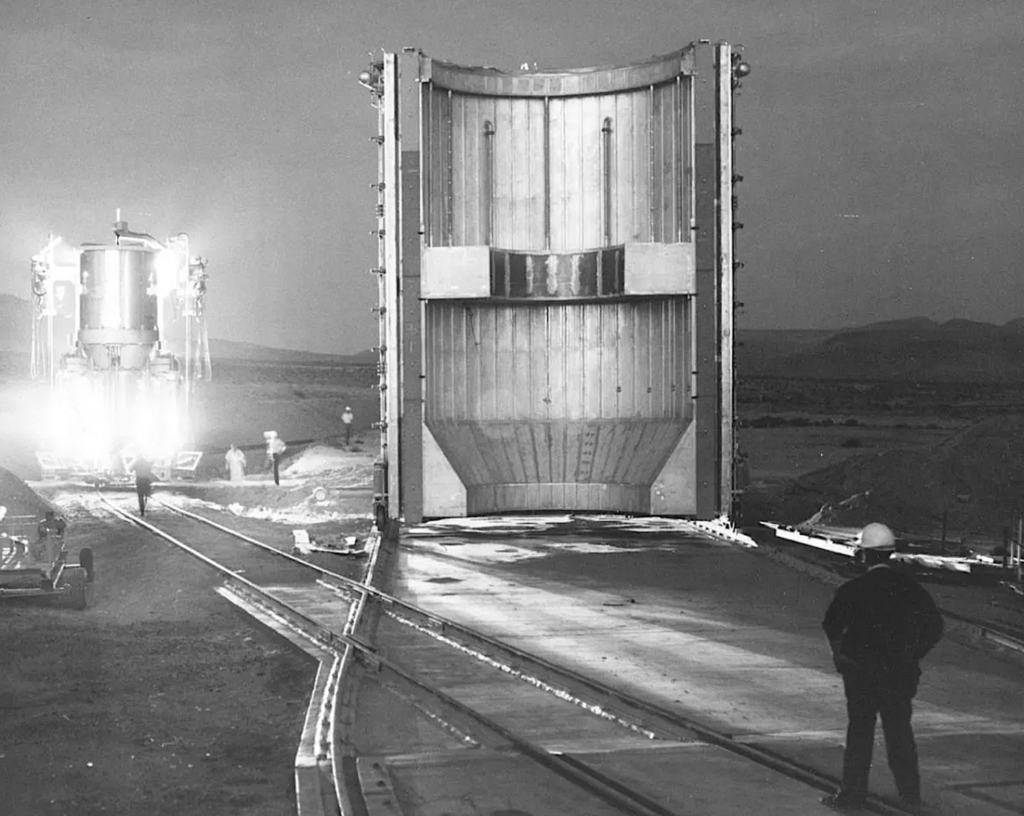
In this convoluted way, a small amount of mass gets converted into energy, leading up to Einstein’s most famous equation: E=MC2. In other words, Energy is equal to mass times the speed of light squared. The speed of light is a very big number, of course, so a kilo of water converted under this formula to energy would give you the amount that a typical power station can produce in six years, according to Brian Clegg. Could that, perhaps, provide us with the secure, safe source of electrical energy we all need? Or would we have to resurrect Einstein from the grave to achieve it. All the methods I have suggested are, of course, impossible, and we will undoubtedly go on plugging in our various appliances and hoping they’ll work. Crooks notwithstanding, they probably will, too, unless we manage to blow a fuse, a not uncommon occurrence for most people. “Power to the people” was a popular slogan back in the late 1960s, as I recall. Sadly, those of us who shouted it loudest never came up with a way to make it come true.

